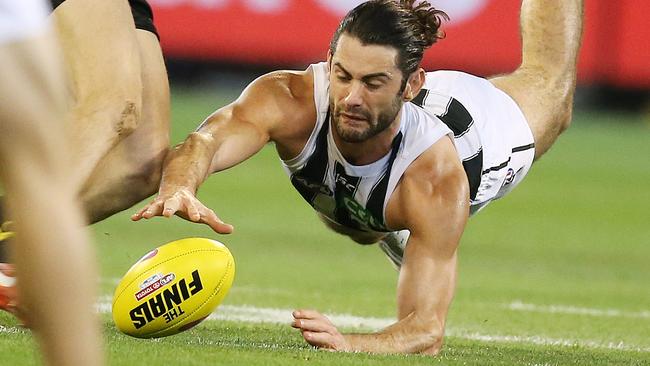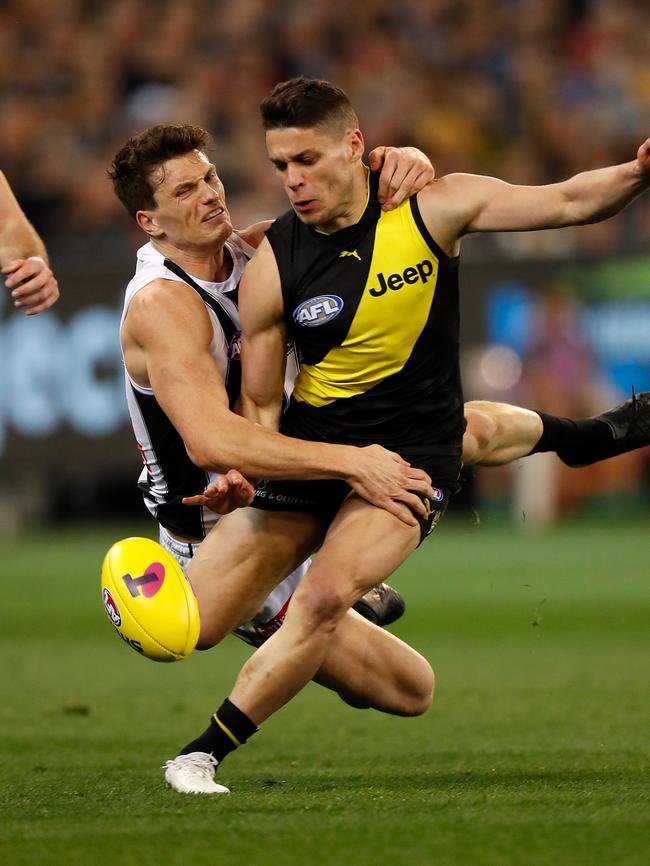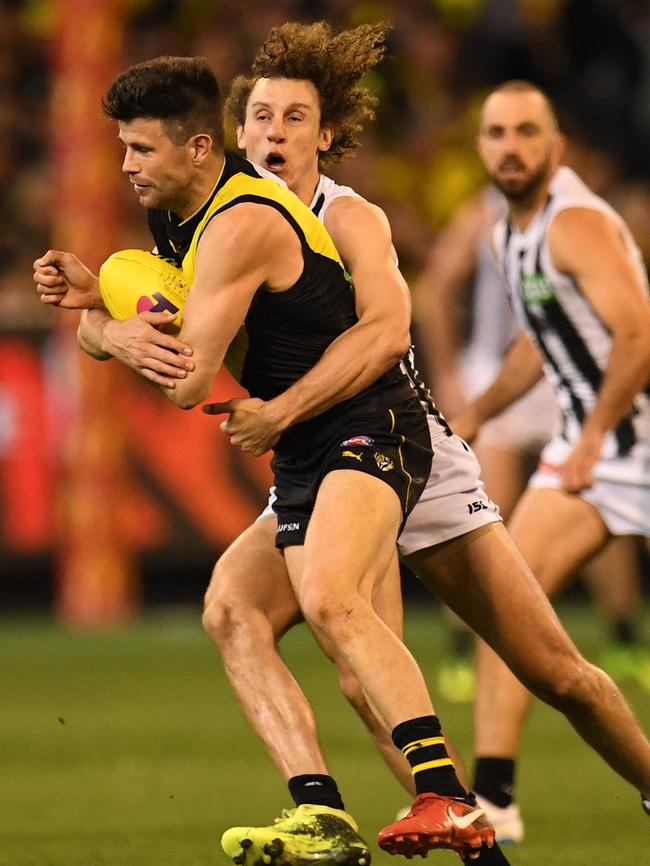Dwayne Russell: Nathan Buckley uses ‘Daryl Braithwaite’ formula to take Collingwood to big dance
COLLINGWOOD’S Nathan Buckley is one win away from being a genius. Not because he has a team full of superstars, but just because he was in tune with where the game was going and knows how to pull off a great cover version.
- Magic moment caps off fairytale win
- Robbo: Is this Collingwood’s greatest story?
- Stunning win as sweet as American pie
COLLINGWOOD’S rise from 13th to grand finalist in one year would be a sexier story if there were some mystery to it.
It would certainly be less embarrassing for a six or seven other AFL clubs and their underachieving players who were leapfrogged by Collingwood this year, if there were some secret herbs and spices to Nathan Buckley’s new game style.
But Collingwood’s recipe for success is more like the recipe for cordial than Coca-Cola. Any AFL coach can mix it. It’s simply Richmond’s old 2017 premiership winning “pressure” recipe — just with a twist.

Few fans realise that AFL pressure is now meticulously measured. Every single contest and every individual possession is logged by Champion Dat under one of seven quantifiable levels of pressure.
A set kick has the lowest level of pressure. A kick in space in general play is also deemed to be very low level. And from there, the pressure scale rises. There is corralling pressure (no-one actually runs at you as you dispose of the ball). Chasing pressure (you are being pursued). Closing pressure (you are certain to be hit). And hands-on physical tackling pressure (someone has you).
Every level of pressure has a specific ratio attached to it. Every player’s game is analysed for how much pressure they applied. And every possession is analysed for how much pressure the player was under.
It shouldn’t surprise any fan that the pressure level is directly related to disposal efficiency.
And disposal efficiency is also directly related to turnover numbers.
And turnover numbers are directly related to scoring.
It’s ridiculously simple. Collingwood and Richmond, who are among the current pressure-rating pacesetters, live and die by the measurement. And their individual players live and die by how they cope with pressure, and how they apply it.
Collingwood added speed and pressure players to its forward half this year. It caused more opposition turnovers and led to more scores.
Under the measurement formula, the AFL average for pressure this year is 180. Richmond registered an above average 185 on Friday night. But Collingwood was able to out-Richmond Richmond, by hitting 196.


Old-school football lovers might laugh at a scientifically designed pressure measurement system. But consider this. Since 2011, clubs have had access to another rarely publicised and extremely unique player measurement system that breaks down the impact and allocates a points value to every possession.
The public don’t see it, because it’s too complex. Most newspapers prefer to publish only the old, easily digested, basic stats like kicks, marks and handballs.
But under the Champion Data player ratings, a 50m kick forward that maintains possession and puts the opposition under pressure, is worth far more than a 20m kick backwards that takes the pressure off the opposition.
A pack mark of an opposition kick on the last line of defence is worth more rating points than an easy mark taken by a full-back who’s team-mate has chipped it backwards to him under no pressure.
The top six players this season under their rating system were Max Gawn, Brodie Grundy, Patrick Dangerfield, Clayton Oliver, Dustin Martyn and Nat Fyfe.

The impact and effectiveness of their possessions are quantifiably above the impact of many players who often get the ball more, but don’t do as much with it.
It’s obvious. All kicks are not equal. And players who can win back the football, and then hit a full-forward’s chest, are worth more than receivers who have the ball given to them and turn it over.
Anyone curious why Port Adelaide had a horrible year should know that the Power had only two players inside the AFL’s top 80 rated players — Robbie Gray (39th) and Paddy Ryder (64th).
The Crows were almost as bad. They only had two in the top 60 — Rory Sloane (22nd) and Hugh Greenwood (42nd). Rory Laird won Adelaide’s best and fairest but on the player ratings ladder, was 86th.
Nathan Buckley is one win away from being a genius. Not because he has a team full of superstars, but just because he understood where the game was going.
He’s about to do a Daryl Braithwaite. Take someone else’s song. Sing it better. And become an icon.
